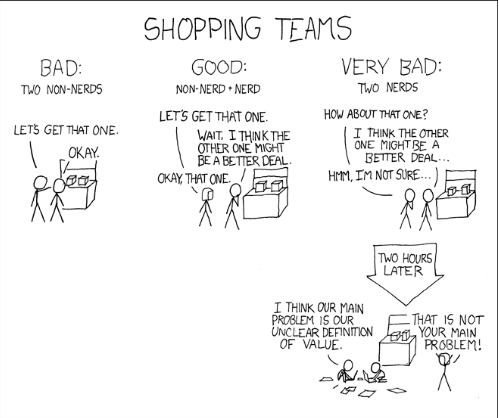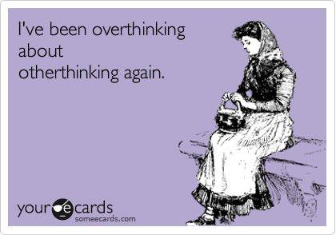
You’re walking out of a restaurant with your date when you suddenly feel a strong urge to duck your head. You realize that doing so will make you look silly in front of your date, who you really like. Do you duck or not?
This is a great time to ignore the possibility of looking foolish and go with your gut. There’s a good chance that your peripheral vision picked up on something aiming at your head that you didn’t have time to process consciously. Maybe some kids are playing baseball nearby and the ball is heading your way, or maybe a pine cone is falling from the tree just outside the restaurant.
The bigger point is that you should generally trust your gut in situations where you’re in physical danger. Even if the object is not going to hit your head, you don’t want to take that chance with the most important part of your body. The same goes for when you’re crossing the street and have a sudden urge to leap away.
Why should you trust your gut in such situations? This quick, automatic reaction of the body result from the Autopilot System of thinking, also known as System 1, which is one of the two systems of thinking in our brain. It makes good decisions about 70-80% of the time, but commits certain systematic errors, which scholars call cognitive biases. This Autopilot System is great for protecting you from physical danger, as evolution optimized this part of the brain to ensure your survival, so your default reaction should be to trust it.
There are some rare occasions in which it goes awry even when dealing with physical danger. For example, you shouldn’t slam on your brakes when you’re skidding on the road, despite what your intuitions tell you. Our instincts will not always be spot-on with physical dangers having to do with modern life. It’s important to learn about these exceptions to going with your gut so you can protect yourself from physical dangers associated with the twenty first-century life.
Also note that some psychological conditions, such as Posttraumatic Stress Disorder, can hijack the Autopilot System and make it less reliable. In these cases, where false perceptions of danger are plentiful, simply trusting the Autopilot System is unwise.
These are the times when you need to use your Intentional System, the more rational part of your brain, to override the intuitive one. It takes effort to turn it on, but it can catch and override thinking errors committed by the Autopilot System. This way, we can address the systematic mistakes made by our brains in our everyday lives.
Keep in mind that the Autopilot System and the Intentional System are simplifications of more complex processes, and that there is debate about them in the scientific community. However, for most purposes, these simplifications are very useful in helping us manage our thoughts, feelings, and behaviors.
Let’s consider a less dangerous aspect of daily life. You’re at an office store to get some supplies for your home office, and are choosing what white-out to get. You rarely use it and have no favorite brand, so the choices seem overwhelming. How much time and energy does it make sense to invest in this decision?
Go with your gut on this one. Since you use white-out rarely, it’s not a good idea to invest time and effort into evaluating all the choices available and coming up with the best one. Just make a reasonable decision that satisfies your needs and get all the other stuff you want as well. This approach applies to all situations where you’re making one-time decisions about minor matters. You’ll waste a lot of time and cognitive resources optimizing rather than satisficing – making a satisfactory rather than an optimal choice.

Now, what about everyday life decisions that are not one-time but regular? For instance, say you eat cereal for breakfast every day. In that case, you definitely don’t want to go with your gut and grab the first satisfactory cereal box you see.
Consider the amount of cereal you eat in a year. Say you go through a box a week. That’s over 50 boxes a year! Imagine them all stacked up in a 3-stories tall pile. That’s a lot of cereal. However, that’s also only a year’s worth. Consider how much cereal you’ll eat in your lifetime. Now you’re getting into skyscraper territory. Envision the nutrients you get and the amount of money it costs. Using such probabilistic thinking, this is a great area to optimize rather than satisfice.
Evaluate the factors that are important to you about cereal: taste, nutrition, cost, and anything else you can think of. Consider and rank the importance of all these elements. Then, compare all the cereals using these factors. Finally, choose one (or more if you want to vary the flavors).
Also, consider whether you can get them cheaper in bulk online than through the local grocery store, depending on the storage area in your home. For example, I eat a lot of tomato sauce and order it in bulk through Amazon, which gives me a 15% discount through their Subscribe & Save service.
The same approach applies to any life decision that you make systematically or anything which you do regularly. If you used white-out a lot, it might be worth the time to pick the best white-out. If you do journaling daily, it’s a good idea to choose a nice journal and good writing implement, even if it takes more time to select them and they are more expensive. The same goes for your office chair—you’ll spend a lot more money and time in the long-run addressing back problems than if you spend some upfront choosing a good chair! This strategy of decision-making, called multiple-attribute utility theory, applies to any instance where it’s worthwhile for you to take the time to make a reasoned decision where you weigh multiple attributes.
However, don’t spend too much time trying to get information beyond the minimal amount needed to make a good decision. Some people fall into this trap when first learning about this technique, a thinking error called information bias—trying to get information beyond that necessary to make a decision. In general, balance the need to get appropriate information with that of making a timely decision to escape the trap of “analysis paralysis.”

The broader principle here is that we are not evolutionarily adapted for a situation where we can make systematic, long-term choices about what to get. Our Autopilot System is optimized for short-term survival. It makes good decisions most of the time, and it’s great for satisficing on one-time, everyday life decisions on minor matters.
However, for anything that is a systematic, repeating choice or something you work with regularly such as an office chair or a pen, it will sometimes steer you in the wrong direction. In those cases, it’s wise to invest the time, cognitive resources, and money in using a more intentional approach to make the best decision for your long-term happiness and success.
Questions to consider:
- Where in your everyday life can you go with your gut more often?
- Where in your everyday life can you use more Intentional System thinking?
- What specific changes should you make after reading this article?




